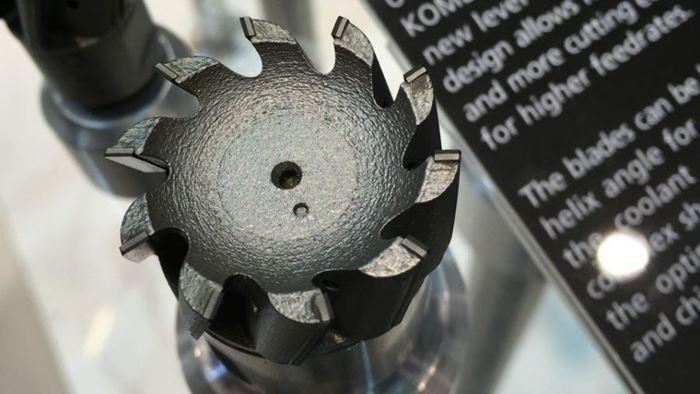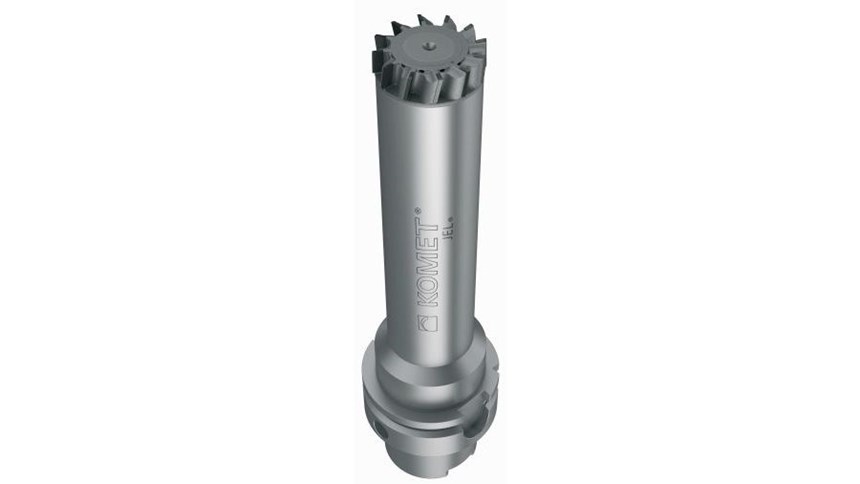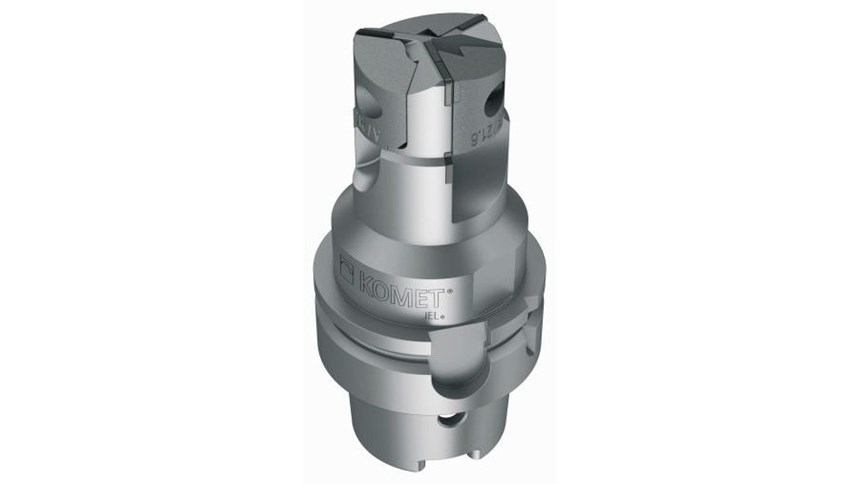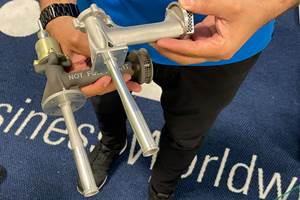Can Additive Manufacturing Increase Milling Feed Rates?
With PCD tooling, yes it can. The diamond cutting edges demand a large number of flutes to realize their full effectiveness. Traditional methods for making cutter bodies limit the number of flutes, but 3D printing is delivering tools with higher flute density and other enhancements as well.
The promise of additive manufacturing will be found in products that are designed for additive manufacturing—that is, products that take full advantage of the geometric freedom that 3D printing can realize. A recent successful example of this relates to milling cutters. Komet's “Revolution” line of milling tools includes tool bodies made through metal additive manufacturing to realize design features including a flute density higher than what is practical to achieve on coventionally manufactured tools. When it comes to cutting edges made of PCD (polycrystalline diamond), more flutes on the tool translates directly to faster feed rate. Thus, Komet is actually using additive manufacturing to make subtractive manufacturing more productive.
Company director of production Cullen Morrison sees making tool bodies through 3D printing as being the way of the future, at least for PCD. This cutting tool material often can take advantage of all the flutes it can get, he says. It is capable of such high material removal rates in the materials it typically cuts—aluminum and carbon fiber composite—that the number of flutes can be the limiting factor on feed rate and productivity. This is increasingly true as facilities using this tooling adopt modern machine tools with high acceleration rates. However, obtaining a high number flutes is problematic in cutter bodies made through machining, because the small pockets resulting form high flute density have to be milled out painstakingly using light cuts with small tools. Additive manufacturing offers a more efficient option.
Now, high-flute-density bodies are grown several at a time at Komet’s headquarters in Germany on a selective laser melting machine from Renishaw. After these bodies are separated via EDM from the build plate used in the additive process, they are ready for the PCD edges to be brazed on. Komet grows only the heads of the tools this way, laser welding them onto the shanks, because the shanks can be manufactured more economically in conventional processes.
Mr. Morrison says the advantages of additive manufacturing for the cutter heads go beyond flute density. There is also the flute pitch. Previously, a pitch of 4 to 5 degrees is the best the company could efficiently achieve, because the clearance challenges of reaching a cutting tool past the flute in order to mill out the pocket precluded a steeper angle than this. But in this case as well, the geometry consideration poses no challenge for additive. On the new tools, Komet has produced flute helix angles up to 20 degrees.
The 3D printed tools likely will also realize longer life, he says. The reason is coolant delivery. With additive, coolant channels can be grown inside the tool along snaking paths that exit precisely where the fluid can be most effective. On previous tools, the positioning of coolant channels was always a compromise resulting from the need to drill a straight hole past the clearance obstacles in the way of this drilling.
One other advantage of additive manufacturing might be the most transformative of all, he says: It will permit faster lead times for special tools. This advantage is particularly apparent to the Schaumburg, Illinois, Komet facility where Mr. Morrison works, because nearly all of the manufacturing here relates to specials. With 3D printing, the range of design options for these special tools increases, and unusual designs specified by special-order customers can move into production practically as soon as they are modeled.
It will take more additive manufacturing capacity to fully realize the promise of the capability for special orders, he says. The company is exploring how far to advance with this means of production, and how quickly. As yet, there is 3D printing capacity only in Germany. But even so, the lead time for 3D printed tool bodies made here is so fast that the distance is potentially no obstacle to serving customers in the U.S. efficiently. He says one possible scenario being discussed for custom tools is this: While the U.S. customer’s special cutter head design is grown additively in Germany, the Illinois facility can simultaneously machine that tool’s shank. The 3D printed head would then be sent to the U.S. and welded to the shank there, ultimately still allowing the tool be delivered within a much tighter window than today’s manufacturing methods make possible.
Related Content
How Does Heat Treating Affect Machining Considerations for a Metal 3D Printed Part?
This picture of part distortion in additive manufacturing illustrates the kind of effects that part design or machining stock allowances need to anticipate.
Read MoreHow Norsk Titanium Is Scaling Up AM Production — and Employment — in New York State
New opportunities for part production via the company’s forging-like additive process are coming from the aerospace industry as well as a different sector, the semiconductor industry.
Read MoreQualification Today, Better Aircraft Tomorrow — Eaton’s Additive Manufacturing Strategy
The case for additive has been made, Eaton says. Now, the company is taking on qualification costs so it can convert aircraft parts made through casting to AM. The investment today will speed qualification of the 3D printed parts of the future, allowing design engineers to fully explore additive’s freedoms.
Read More8 Cool Parts From Formnext 2023: The Cool Parts Show #65
New additive manufacturing technologies on display at Formnext were in many cases producing notable end-use components. Here are some of the coolest parts we found at this year’s show.
Read MoreRead Next
Looking to Secure the Supply Chain for Castings? Don't Overlook 3D Printed Sand Cores and Molds
Concerns about casting lead times and costs have many OEMs looking to 3D print parts directly in metal. But don’t overlook the advantages of 3D printed sand cores and molds applied for conventional metal casting, says Humtown leader.
Read MoreGE Additive Rebrands as Colibrium Additive
As part of the brand name transition, both the Concept Laser and Arcam EBM legacy brands will be retired.
Read MoreVideo: Intelligent Layering Metal 3D Printing at 3DEO
Contract manufacturer 3DEO delivers metal parts using Intelligent Layering, a binder jetting-like 3D printing process the company developed and operates internally. Here’s how it works.
Read More

















.png;maxWidth=300;quality=90)









